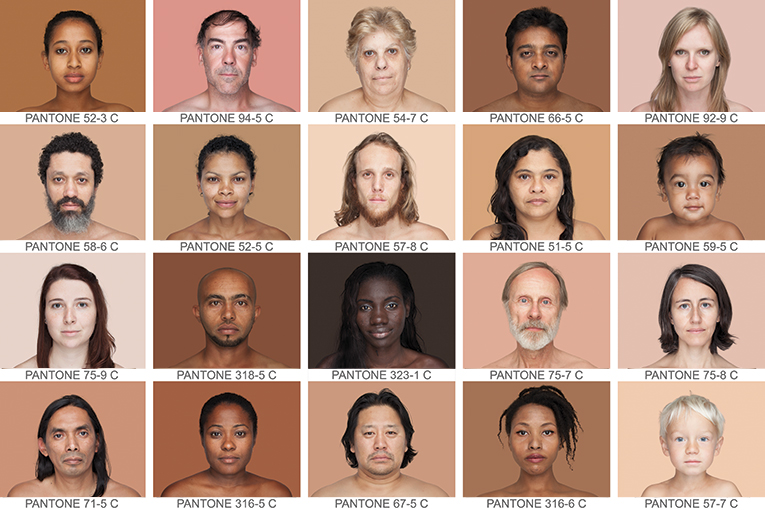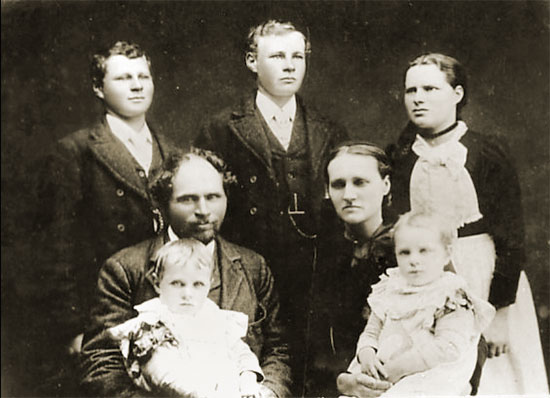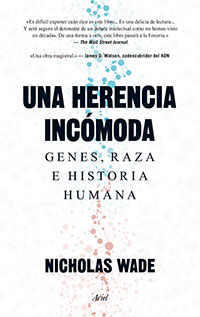
|
Wade’s case Nicholas Wade, former editor of prestigious journals such as Science and Nature, and writer in the science section of The New York Times for many years, caused much controversy when his book A Troublesome Inheritance; Genes, Races and Human History was published last year. Basically, Wade claims that new genomic studies, far from discarding the idea of human races, provide evidence of their existence, because they show that there is a geographical structuring of human genetic diversity. For example, when analyses like the so-called principal components analysis (PCA), which reveals the underlying data set (in this case, genetic data), are carried out, individuals from each population tend to cluster, which results in a geographical map of the study area. For example, when analyzing a large number of European individuals, and without altering anything in the analysis, we end up getting a fairly reliable map of Europe. This is so because over the past centuries the people in each population has more often than not tended to mate with their neighbours. Studies carried out with current European genomes have shown that, on average, two Europeans picked at random from two nearby towns, share between two and twelve ancestors of the past 1,500 years. When we look back a thousand years, in the Middle Ages, the number of ancestors shared the same period increases to 100. Despite this web of interconnections to the past, there is a stable geographical structure because common ancestors tend to gather in a particular region. That is, a current inhabitant of the Iberian peninsula is 100 times more likely to have inherited genetic material from 1,000 year old Iberian than from a contemporary individual from, for example, the Balkans. For individuals of «mixed» ancestry (i.e. with populations from different ancestors), this structure allows us to even classify chromosomal fragments according to region. My own genetic material, for example, is 24% from northern Europe and 1.2% can be traced without any doubt to the British Isles; the latter «English» fragments can be found in chromosomes 4, 11 and 12. This is a consequence of having an English grandfather, who contributes a quarter of my genetic makeup. When some ancestors come from other continents, it is even easier to trace our genetic legacy, and often surprising personal stories are discovered. A friend of mine who works for deCODE Genetics is studying 500 Icelanders, descendants of Hans Jonathan, who had a very interesting life. He was born in a Caribbean plantation in Santa Cruz in 1784 the illegitimate son of the Danish governor of the West Indies and an African slave. Later the family returned to Denmark and after his father’s death, came under the tutelage of his stepmother, who treated him like a servant. Hans ran away from home and fought with the Danish Navy in the Napoleonic Wars, where he stood out for his bravery. Shortly afterwards he was arrested by the Danish authorities, who, in a famous trial, ruled that Hans had to return to the West Indies as a slave. He fled again, this time to Iceland, in 1816.There he married an Icelandic woman who bore him two children. Their offspring, which even includes a former Icelandic Prime Minister, David Oddsson, extends to the present. Well, researchers from deCODE can perfectly identify Jonatan’s African chromosomal fragments scattered among current Icelanders. In fact, researchers estimate that they may retrieve about 40% of Jonatan’s genome without analyzing it directly. THE STRUCTURE OF HUMAN DIVERSITY In fact, geneticists have never denied that there was a part of the variation structured according to continents, and within continents, according to populations. What this entails, however, is far more complex than Wade seems to understand. For example, Wade refers to works such as Noah Rosenberg’s (now at Stanford University), 2002. In this study, a type of analysis seems to prove, according to Wade, a race division in the human species by using a computer programme called Structure. This observation is not correct. Structure is based on algorithms that use information of variable positions along the genome (up to several million) in order to show the structure between populations. It also provides an elegant display of the ancestry of each individual. However, the programme provides different groupings of individuals depending on the number of populations we enter. In this type of analysis, when we say there are two populations, it distinguishes Africans and Europeans from Asians; when there are three, Africans, Europeans and Asians have their own group; with four, it distinguishes Amerindians from Asians; with five, Melanesians from Asians. From this point, interesting things happen. For example, with six populations the Kalash, a small and isolated group from Pakistan, is shown separately (I suppose nobody would think about them as a «race» the same way they do regarding Africans). Thus, depending on the number of subdivisions, we get more or less «races». The fact that the third or fourth division matches superficially with the number of races that Wade claims, does not mean that this division is more valid than the fifth or the sixth division. However, if you look at the individuals within each population, we see that this analysis precisely shows a large variation within populations, which are clearly defined by the mean values of the frequencies of genetic markers. This is not at all surprising. We have been considering the same concepts for a long time, which can be summarised as follows: most human genetic variation (around 85% or more) can be found among individuals within the same population; a minor part (about 10%) among major continental areas, and an even smaller portion (perhaps 5%) among neighbouring populations. However, the genome is so great that even with this small fraction of genetic variation we are able to separate adjacent populations and to assign individuals to populations with a high probability of success. That being said, it is important to emphasise two more ideas. The first one is that the fact that there is a certain geographical structure of the variation that nobody denies does not mean it can be subdivided into categories below the species level. Simply, we have no objective criterion for us to say that there is this or that many categories; any division we outline will be arbitrary, as shown by analyses carried out with tools like Structure. The second idea is that it would not make much biological sense to subdivide a species –human or any other– based on such a small geographically structured genetic diversity fraction. That again is not unusual: it is the result of the recent origin of our species, which is less than 200,000 years old. |
«Wade argues that new genomic studies, far from discarding the idea of human races, they provide evidence that support their existence» | |
 The biopharmaceutical company deCODE Genetics is studying 500 Icelanders, descendants of Hans Jonathan, born in a Caribbean plantation in Santa Cruz in 1784, the illegitimate son of the governor of the Danish West Indies and an African slave. Researchers at deCODE can perfectly identify Jonatan’s African chromosomal fragments scattered among current Icelanders. In the picture, picture book of Hans Jonatan’s family. The biopharmaceutical company deCODE Genetics is studying 500 Icelanders, descendants of Hans Jonathan, born in a Caribbean plantation in Santa Cruz in 1784, the illegitimate son of the governor of the Danish West Indies and an African slave. Researchers at deCODE can perfectly identify Jonatan’s African chromosomal fragments scattered among current Icelanders. In the picture, picture book of Hans Jonatan’s family. |
«Geneticists have never denied that there was a part of the variation structured according to continents, and within continents, according to populations. What this entails, however, is far more complex than Wade seems to understand» | |
|
REACTIONS FROM ACADEMIA At the same time, the scientific community’s reaction against Wade might seem quite disproportionate. One hundred thirty-nine researchers signed a letter published in Nature in August 2014, where they claimed that Wade had misinterpreted the results of his research to support his ideas. Outside academia, people could think it was the reaction of an establishment which defended its funds in a very sensitive issue for the public, especially in the US. However, as Wade himself said in an interview, «if I had manipulated or misrepresented research, how many scientists would be necessary to clarify the situation? Surely, only one.» I think it is very easy to join a list –in many cases without having even read the book under scrutiny –and, conversely, it is a lot more difficult to thoroughly discuss this very uncomfortable issue. In my opinion, the responsibility of scientists to society is the second option. DIFFERENCES IN SOCIAL BEHAVIOUR? The ideas of the second half of Wade’s book are more interesting as an intellectual debate than the anachronistic concept of race, however, they seem to have passed unnoticed. I am talking about the possibility of geographical differences not at all linked to social behaviour. If that were so, we might think, as Wade argues, that cultural differences in human populations are due to innate differences in behaviour and not the other way around. We know that human populations come from recent African migrations of a few thousand individuals. During this process, which took place a few ten thousand years ago, humans are genetically differentiated by two mechanisms: the effect of chance in out of Africa migrations and the action of selection to adapt to new and varied climate and ecological conditions. The first mechanism seems to be the most important from a quantitative point of view, but the second explains some of the most obvious differences between human populations, such as those regarding pigmentation and body proportions. In recent years, we have discovered genetic variants associated to skin, hair and eye colour, with pathogen resistance or metabolic issues (e.g., the ability of current European populations to digest milk), and their presence differs according to the population studied. Could it be that behaviour had also acted as a local adaptive factor and therefore this is reflected in genes? Wade lists possible examples: he believes that Africans are predisposed to tribalism; while Chinese populations are predisposed to be subject to authority and Jews are adapted to capitalism. When he elaborates these issues, we find that his arguments require a certain degree of credulity. For example, Wade believes that Jews are smarter –they are overrepresented among Nobel prize winners –because, ever since the Middle Ages, they were moneylenders of Christian noblemen and those better skilled for maths were chosen within the community. That would explain, he said, their being smarter than other groups as a result of this selective process of the last five hundred years. Most would agree, I think, that it is more plausible that it all comes down to a cultural issue. To study these traits we face first the enormous difficulty of ascertaining the hereditary basis of social behaviour. Traits such as intelligence depend on thousands of genes as well as strong environmental components. Right now we are not, I think, in a position to study these traits in depth –in fact, often we are not in a position to define them objectively– , therefore Wade’s entire argument is purely speculative. It is an interesting idea worth studying, but personally I think there is little chance of it being true. The cultural differences Wade refers to are very recent and it seems that evolution has not had enough time to act. I think it will be difficult to find genetic differences involved in social behaviour, and that this is a consequence of a previously established cultural diversity. THE GREAT HUMAN FAMILY Even if it was so, if ever any significant cognitive difference was found in any human group, humans’ common ancestry would be much more important, both quantitatively and qualitatively. We have to imagine our species as a large interconnected network of individuals that is projected into the past as well as into the future; the bonds that hold us all together will always be more important than minor differences in some points of this so strongly shared evolutionary history. And this is no ethical argument, but a biological reality. Carles Lalueza-Fox. Researcher, Institute for Evolutionary Biology. CSIC-Universitat Pompeu Fabra, Barcelona.
|
|
|

 A Troublesome Inheritance (Spanish Translation Cover)
A Troublesome Inheritance (Spanish Translation Cover)



